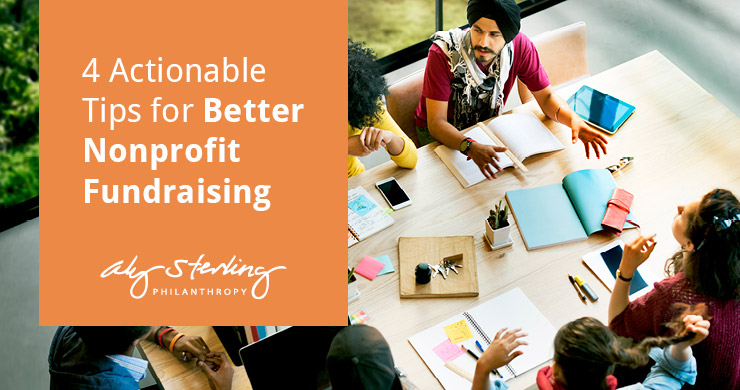
Fundraising invites philanthropic supporters to be involved in the causes they care about. Their generous contributions are the whole reason nonprofits can continue working toward their missions. Because of this, you’ll need to ensure these individuals stay engaged and have every opportunity to give. Otherwise, you may lose their vital support.
If you’ve noticed a drop in supporter engagement and retention, it may be time to adjust your fundraising plan. When doing this, keep in mind that as your nonprofit continually develops, so should your fundraising strategy. This ensures you’re making the most of your organization’s time and resources as they grow.
It’s important to note that each nonprofit finds success in different techniques, but the fundamentals are the same for everyone. When revamping and refining your organization’s fundraising strategy, employ these proven best practices to reach your potential:
- Create a strategic plan for grant seeking.
- Build relationships with donors and funders.
- Convey meaningful messages through storytelling.
- Seek help from fundraising consultants.
In the fast-paced world of fundraising, it can be challenging to keep up and consistently engage prospects. Making good use of time and resources is paramount to your success. Create an immersive, adaptive fundraising approach, and watch as more supporters advocate for your cause.
Ready to engage supporters and compel more donors and funders to give? Let’s dive straight in!

1. Create a strategic plan for grant seeking.
A smart fundraising strategy includes a plan for grants that is proactive instead of reactive. It’s important to note that grants should never be a backup plan. Rather, you should consider and prioritize them from day one.
Every organization should develop its own, strategic approach to grant seeking. Particularly, your plan should take your nonprofit’s time, needs, and resources into consideration. Whether your organization is big or small, you’ll want to focus on the right funders at the right times for the right purposes. Otherwise, your efforts will go to waste.
Grant seeking is highly competitive and challenging, especially when requesting support from a foundation for the first time. Often, nonprofits waste time seeking the wrong grants or misdirecting their proposal. To close this knowledge gap and maximize your chance for success, take the time to understand the process step by step:
- Identify the most appropriate funders. Make sure to research funders before reaching out to them. Focus on finding grantmakers whose priorities align with yours and whose eligibility requirements you fulfill. By doing this, you won’t be chasing unlikely funders.
- Seek personal connections. A personal connection can open the door to a conversation and result in an invitation from the funder to apply. To identify any existing relationships, check with your staff, board, donors, and other constituents.
- Write an effective proposal. Using the direction provided by the funder, tailor your writing and ensure that it reinforces the unique alignment between their foundation and your organization. Make sure to emphasize their role in your potential success. For additional proposal tips, explore this comprehensive nonprofit grant writing guide by Grants Plus.
- Follow up. Instead of waiting until the next proposal is due, stay in contact with funders and show your appreciation when they award you grants. Also, deliver on any promises you made, whether that’s tracking outcomes or publicly acknowledging the foundation.
Remember, grant seeking is all about being targeted and relationship-based in your approach. By incorporating a strategic grants plan in your nonprofit’s fundraising efforts, you’ll set yourself up for success.

2. Build relationships with donors and funders.
Identifying possible revenue opportunities is not enough when it comes to nonprofit fundraising. Rather, you have to take the time to develop authentic relationships with funders and supporters. After all, these are real people who care about your cause.
Fundraising—grant seeking especially—is based on relationships. You’ll need to acknowledge that these grantmakers and donors are seeking to financially support organizations whose priorities and goals align with theirs. Making the connection and building the relationship is of the utmost importance when seeking funding of any kind.
To improve your efforts, you should constantly be in the mindset that every day is a campaign day. With this mentality, you’ll automatically heighten communications with supporters, allowing you to cultivate solid relationships with them.
Further, securing donations and winning grants doesn’t happen by sending vague appeals that aren’t tailored to anyone in particular. Rather, they come as a result of growing relationships through personalized outreach. It may be possible to secure funding without first establishing a relationship, but it’s much more challenging.
Build stronger relationships by putting the donor and grantmaker first. To start off on the right foot, get into the habit of conducting prospect research. Learn what connections they have to your cause before you reach out. This could be similar priorities, common goals, or a pre-existing relationship. Explore Double the Donation’s prospect research guide to learn how to more effectively acquire this information.
When you have a solid understanding of who you’re pursuing, you can effectively reach out using a personalized approach. Specifically, when grant seeking, it’s vital that you attempt to establish a relationship before applying for a grant unless the funder explicitly prohibits personal outreach. That’s because funders rarely award grants based on the proposal alone. Disregarding this step can put you on the fast track to rejection.
Remember, at the heart of any solid relationship is trust. Donors and funders both need to trust that your organization:
- Has a strong, positive reputation.
- Offers a realistic approach to a real need.
- Has responsible leadership.
- Fulfills its plans and promises.
Cultivating strong long-term relationships should be one of your top priorities. Always make sure to pursue the right funders at the right time and to communicate in a genuine and respectful way. When donors, grant funders, and other constituents feel respected, they’ll be much more committed to your cause. Explore these additional actionable tips to help boost your retention rate.

3. Convey meaningful messages through storytelling.
It’s not enough to state why you need the funding and share some statistics to back up your claims. While this is an important part of fundraising, you’ll need to go above and beyond if you want to secure donations and win grants. To compel donors and grant funders to support your cause, you’ll need to dabble in storytelling.
Storytelling is a powerful way to promote your fundraising efforts. Many nonprofits incorporate narratives as a way to develop their brand and inspire action. This allows donors and grantmakers to form a deeper connection with your cause, which makes them more likely to get involved. With each campaign and fundraising appeal, organizations should focus on telling a powerful story to convey meaning and evoke emotion in the reader. To accomplish this, keep these best practices in mind:
- Find a balance between passion and urgency. Any story you tell should showcase the enthusiasm you have for your organization or program while also conveying the need for the reader’s immediate involvement.
- Know your audience. Consider how you’ll be evaluated so that you can accurately connect with your reader. The more you know about them, the more you can spark their interest with your story.
- Call the reader to action. Make the point that without their assistance, your organization or program won’t be able to fulfill its purpose.
Once you’ve mastered verbal storytelling, take it one step further by featuring powerful imagery with every appeal. Share photos and videos of your work in action. This could include anything from your generous donors to those who are impacted by your work. Use infographics to tell stories to funders who are digital natives or visual learners, too. However, don’t overload your appeals with images as this can distract readers. Rather, use them sparingly as a way to break up text and drive your points home.
From grant seeking to donation appeals, storytelling isn’t something any nonprofit should overlook in its fundraising strategy. Featuring truthful, inspiring stories with impactful imagery helps to foster strong communications and familiarity so that your future donation and funding proposals are much more effective.
4. Seek help from fundraising consultants.
Some fundraising techniques require extensive practice before they yield any results. That’s not to say that your organization shouldn’t attempt these strategies. Rather, you may need to seek external help to fulfill your fundraising potential.
Fundraising consultants are a very wise investment. They give you the competitive edge you need to secure funding and save your team time. From grants consultants to fundraising strategy firms, professional help is out there for a wide variety of fundraising techniques.
By enlisting professional help, you can focus on cultivating relationships, finding additional sources of revenue, and developing stronger leadership. Consulting firms can offer a fresh perspective on your organization and can help you form a solid, strategic plan to achieve your fundraising goals.
Hiring a fundraising consultant may take a bit of time, but with the right expertise, you’ll secure more funding quicker and more effectively. Here’s how the process works:
- Determine your organization’s needs and goals.
- Identify the services you need.
- Research potential consulting firms.
- Narrow your list down to those that fulfill your specific needs.
- Meet with top candidates and make a selection.
Outsourcing time-consuming work can boost funding and propel your fundraising efforts forward. Leave any confusing work to those with industry knowledge and experience.
You’ll save time while also picking up useful knowledge when you find the right consulting firm.To help find the perfect consultant for your organization, take a look at Aly Sterling’s top fundraising consultants guide. You’ll find professionals for everything from data analysis to grant management.
No matter the size of your organization, fundraising is challenging. You should continually expand your approach, which isn’t always easy to accomplish. As you contemplate your fundraising strategy, remember to develop a strategic grants plan. While approaching a funder for the first time can be challenging, grants are a vital part of any sustainable fundraising plan.
Whether you’re communicating with donors or grantmakers, always prioritize authentic, communicative relationships. Using powerful storytelling is a proven way to accomplish this. You’ll make them feel vital to your cause and inspire action. Then, to take your efforts to the next level, seek external help from fundraising consultants. You’ll be backed by the professional knowledge you need to reach your goals. Employ each of these tactics to the best of your abilities, and watch as support grows!
 About the Author: Matt Carter, Director at Grants Plus
About the Author: Matt Carter, Director at Grants Plus
Matt’s experience includes grant development, corporate giving, individual fundraising, government relations, policy analysis, and project management for a variety of policy, social service, and cultural organizations.
Before coming to Grants Plus, Matt served as Associate Director of Development, Foundations and Grants, at the Western Reserve Historical Society, and as Director of Development at New Life Community (now Family Promise of Greater Cleveland). He has been published in journals in the US and Europe, and co-authored the book, Seen But Not Heard: Strengthening Nonprofit Advocacy. Matt serves on the board of the Association of Fundraising Professionals Greater Cleveland Chapter. He holds a BA in Political Science from the State University of New York at Buffalo.